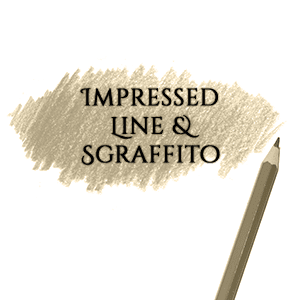Colored Pencil Tips & Techniques:
The History and Types of Colored Pencils
It's All About Colored Pencils!
Colored pencils are a relatively new medium. Colored pencils were first introduced in the early 19th century. However, it wasn't until the early 20th century that colored pencils were of a high-quality standard. For the longest time, colored pencils were not considered a serious art medium and were scoffed upon by prestigious art galleries and fine artists. Today, however, colored pencil art is becoming more and more widely accepted in galleries and winding up in the hands of many art collectors. Renowned colored pencil artists such as Vera Curnow, Ann Kullberg, Alyona Nickelsen, Gary Greene, Jeff George, Jeffrey Smart Baisden, and Jesse Lane have helped this medium find its way into well-known art galleries. Thanks to these and many other colored pencil artists, colored pencil art is now regarded as a serious art medium.
Historical Timeline of Colored Pencil Companies
- During the early twentieth century, the colored pencil core was developed. The core consisted of a combination of pigments or dyes and a binder.
- In 1761, a small factory in Germany began making the pencils Kaspar Faber, later to become the world-famous Faber-Castell company. Over time, the company has improved the quality of its colored pencil and has created "modern techniques of industrialization" of colored pencils. In the early 1920s, the A.W. Faber Company began selling over 60 different shades of colored pencils for artists. Faber-Castell is considered one of the most popular brands of colored pencils today.
- In 1806, the German company Lyra was established by the pencilmaker Johann Froescheis.
- In 1832, the British company, Derwent, began manufacturing pencils, and in 1932 they developed their first colored pencils.
- In 1834, Staedtler produced their first oil pastel colored pencil, and in 2005, they developed a protective Anti-Break-System (A•B•S) coating for colored pencils to keep them from breaking.
- In 1855, the Schwan-STABILO Company was established in Germany. In 1925, they developed and launched the first thin-lead colored pencil.
- In 1790, L. & C. Hardtmuth Company of Austria and Hungary introduced their Koh-I-Noor brand pencils. They named the pencils after the famous diamond. Their woodless colored pencils were later developed and sold under the “Progresso” trademark.
- In 1913, the Tombow Pencil Co., Ltd. was established in Japan, and they began manufacturing colored pencils. They are known in the colored pencil world for the Tombo Irojiten Colored Pencils in which the company introduced in 1988. "Irojiten" is the Japanese expression for "color encyclopedia."
- In 1924, in Switzerland, the company Geneva Fabrique pencils changed its name to Caran d'Ache after a famous French cartoonist. In 1931, they developed Prismalo, the first water-soluble colored pencil. In 2008, they developed a high lightfast set of colored pencils called Luminance 6901. Caran d'Ache is one of the most popular colored pencil brands of today.
- In 1938, the Eagle Pencil Company introduced the Prismacolor Pencil. In 1969, the Eagle Pencil Company changed its name to Berol Limited. Later in 1995, Berol was purchased by Sanford. Sanford Prismacolors is one of the most popular brands of colored pencils today.
Types of Colored Pencils
Professional Grade Wax/Clay Based Color Pencils
- Caran d'Ache Luminance Colored Pencils (76 colors available, smooth, soft and lightfast, water resistant). Color Chart
- Derwent Coloursofts (72 colors available, soft, smooth, blends well, velvety, lightfast, little wax bloom, acid free, water-resistant). Color Chart
- Prismacolor Premier Soft Core Colored Pencils (150 colors available, blends well, vibrant, soft, smooth, creamy, lightfast, water-resistant, not break-resistant).
- Prismacolor Premier Verithins (36 colors available, hard thin lead, great for details).
- Tombo Irojiten Colored Pencils (100 colors available, many soft pastel colors, smooth blending, medium hard waxy leads, some colors are extremely light, great for detailed work).
Professional Grade Oil Based Colored Pencils
- Caran d'Ache Pablo Colored Pencils (120 colors available, dry lead, water-resistant, lightfast). Color Chart
- Faber-Castell Polychromos Pencils (120 colors available, lightfast, smooth, break-resistant, water-resistant, smudgeproof).
- LYRA Rembrandt Polycolor Pencils (78 colors available, lightfast, blendable, water-resistant, no wax build-up, mixes well with Prismas, great for detailed work, hard lead).
- Marco Raffine Professional Colored Pencils (72 colors available, vivid colors, smooth, soft lead).
- Derwent Lightfast Colored Pencils (100 colors available, soft to medium lead, smooth, velvety, vibrant colors, lightfast, strong points). Color Chart
- Koh-I-Noor Polycolor Colored Pencils (72 colors available, water-resistant, are wax-based but contain special oils in the pencil lead, smooth, lightfast, dense strokes, not break-resistant, great for detailed work). Color Chart
Professional Grade Water-Soluble Based Pencil Brands
- Caran d'Ache Supracolor Soft Aquarelle (120 colors available, water-soluble, lightfast, soft). Color Chart
- Caran d'Ache Museum Aquarelle (76 colors available, water-soluble, lightfast, soft). Color Chart
- Cretacolor Marino Watercolor Pencils (36 colors available, water-soluble, lightfast, soft, blendable).
- Derwent Watercolor Pencils (72 colors available, water-soluble, smooth, creamy, soft, lightfast, blends well).
- Faber-Castell Albrecht Dürer Watercolor Pencils (120 colors available, smooth, water-soluble, lightfast).
- LYRA Rembrandt Aquarell Artists' Colored Pencils (72 colors available, lightfast, smooth, water-soluble, bright colors, blendable).
- Prismacolor Premier Water-Soluble Colored Pencils (36 colors available, smooth, creamy, water-soluble, blends well, lightfast).
- Staedtler Karat Aquarell Premium Watercolor Pencils (60 available colors, smooth, soft, water-soluble, blends well, break-resistant, vibrant, lightfast).



































